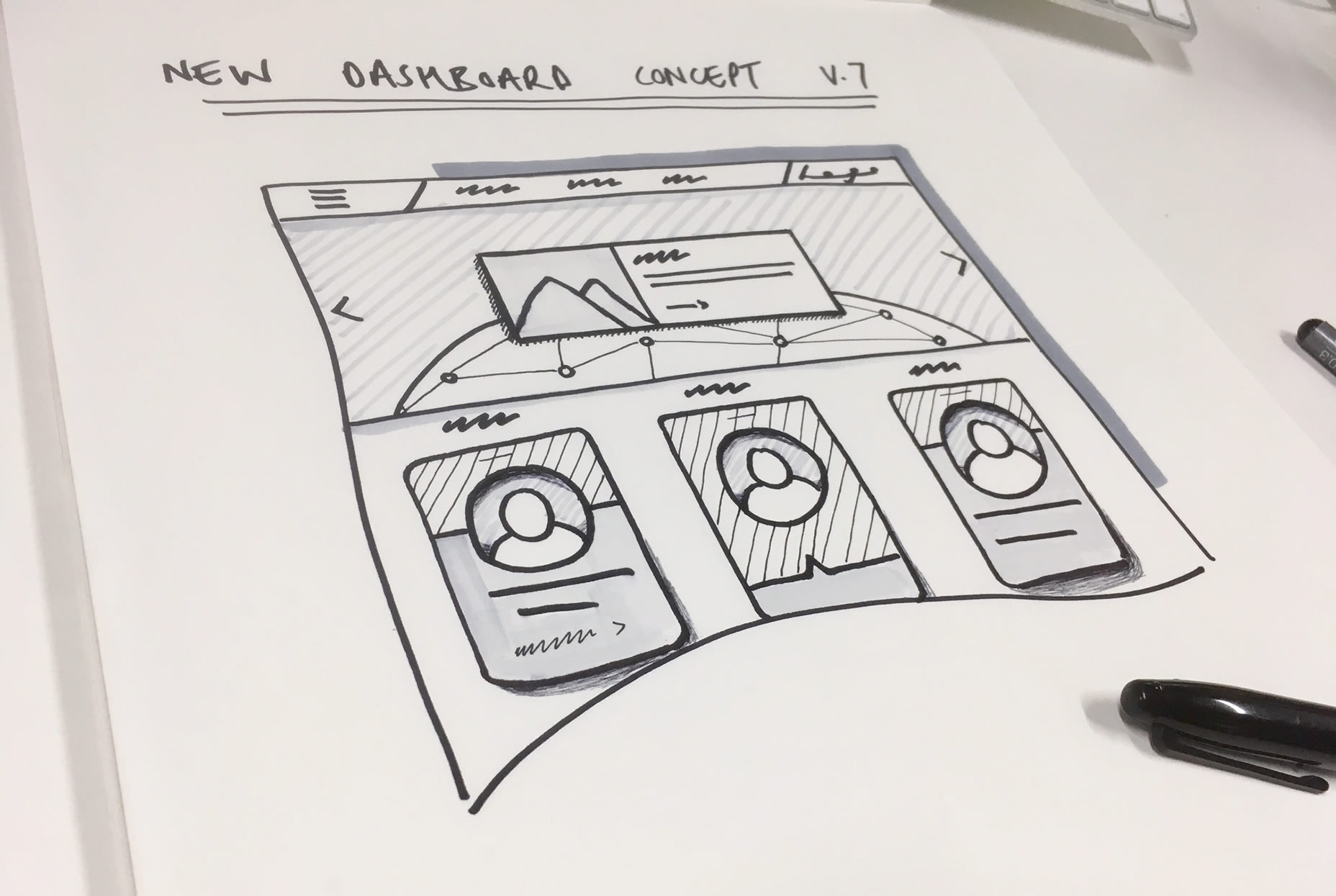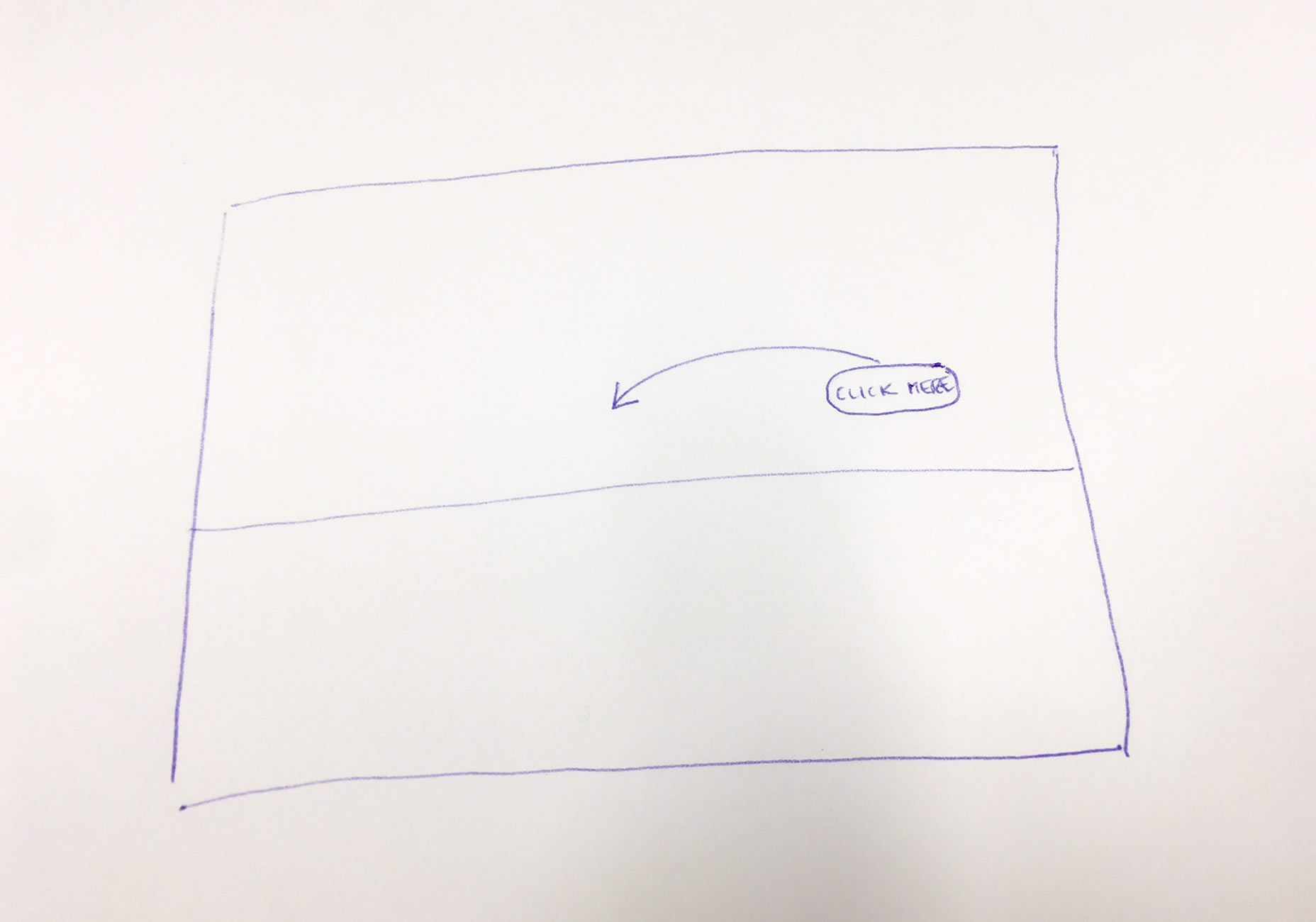
 This creates a fear in everyone else that their quick scribble on a post-it note or napkin isn’t good enough, that the snooty designers might point and laugh and at it (sadly not always an unreasonable fear).
But it’s one we need to dissuade as much as possible—there’s huge value in getting all the people involved in any web design project comfortable with sharing their thoughts and their feedback visually.
If you still need convincing, imagine this scenario - a classic email ping pong conversation that we’ve all experienced before:
Client: Hey, Can you move the block to the centre. Thanks
This creates a fear in everyone else that their quick scribble on a post-it note or napkin isn’t good enough, that the snooty designers might point and laugh and at it (sadly not always an unreasonable fear).
But it’s one we need to dissuade as much as possible—there’s huge value in getting all the people involved in any web design project comfortable with sharing their thoughts and their feedback visually.
If you still need convincing, imagine this scenario - a classic email ping pong conversation that we’ve all experienced before:
Client: Hey, Can you move the block to the centre. ThanksYou: Hi, Yeah sure which block? Regards
Client: Hello, Just the one at the top please.
You: Hi, Ermm do you mean in the header?
Client: Not sure, is the header the top bit?
You: Yes the element at the top of the page with the hero banner and primary CTA
Client: Sorry you’ve lost me, it’s the button you click that I want moving
You: Ah right...which button? [crying noises] Instead of 18 wasted emails of 2 difficult phone conversations and a nervous breakdown, imagine this being the conversation Client: Hey, Can you move the block to the centre - like this. Thanks
 So how do we do this? how do you convince ‘Brian from Accounts’ that he can, and should, sketch out his ideas for the new finance software?
So how do we do this? how do you convince ‘Brian from Accounts’ that he can, and should, sketch out his ideas for the new finance software?
How
So if the main blocker for most people is a perceived lack of artistic skills “I couldn’t possibly draw something I’m not a designer” right off the bat you need to make sure everyone knows that the neatness or attractiveness of a sketch is irrelevant. People need to see a sketch as just a quick and easy way to communicate certain things, with the emphasis on quick. One of my favourite ways to frame it with people is to politely ask “would you be able to do me a real quick rough sketch of that? Nothing detailed, just scribble it out and send me a pic of it?” Usually this is enough for good old Brian from accounts to pick up a pen and give it a try but there can be others issues.Logistics
With the remote nature of some teams and clients it’s rarely as easy as walking round to someone’s desk with the actual paper a sketch is on. Faxing it is a little retro and mailing it might take a while! But thankfully technology easily comes to the rescue, just encourage people to scan their sketch or even take a picture on their phone if needs be. Easy to use software that allows digital sketching such as inVision also exists. These tools allow amazing ways to collaboratively sketch, but while they are indispensable to many UX Designers it’s always worth considering how daunting this might feel to the audience we’re talking about before suggesting it.Not My Job
As we’ve discussed the biggest barrier to getting everybody on board with sketching is usually a fear of being laughed at—‘how stupid and quaint it is that Brian from accounts thinks he can design now.’ This is even more true of your senior clients or stakeholders—this stems from the fact that there’s something quite vulnerable about presenting things that you’ve drawn yourself. A CEO of a massive mega global organisation may be very comfortable firing off written directions in email form but sketching some feedback to go along with it won’t come naturally to them at all; it’s not their job. To get round this one it’s a case of setting expectations and positioning a sketch as nothing more than a scribble, something that won’t be viewed based on its artistic merits or shared unnecessarily. What I’ve found works well in the past is to demonstrate this. By this I mean actually creating a super rough and ugly sketch yourself early on in the project to prove a point. Show everyone that it’s ok to share that ‘napkin sketch’ without fear of it being publicly mocked.When
So now you’ve (hopefully) got everyone onboard with sketching is there a right and a wrong time to entourage it? In truth whenever you’re involving others in your project you should be pushing people to express themselves through a quick scribble—communicating ideas visually just works better nine times out of ten. There are however points in a project where you’ll find you can get the best out of sketching as a methodology, in my experience there are 2 key areas that benefit most.Ideas Time
Early idea generation is a fantastic time to be encouraging the quick iteration of ideas that sketching allows - ideally with everyone in the same room clutching a sharpie. You’ll find that by getting everyone actively contributing to the creative process, regardless of their role, will remove a number of project hurdles very quickly - it also has the unexpected benefit of helping you get buy-in from everybody if they feel like they had an active hand in defining your design solution. If they drew a little bit of it themselves - they’re invested! A nice simple way to get people sketching in this kind of situation is to lay the room out so that everybody has a pad and pens sat in front of them begging to be picked up and used.Feedback Loops
Any point at which feedback is being gathered is the other time where I’ve found you can get the most benefit from encouraging everybody to sketch. The biggest benefit you’ll likely see here is the wonderful time saving you can get from removing misunderstandings (and the inevitable frustration that comes with them). Obviously receiving a tiny sketch of every single feedback point from every single stakeholder would quickly drive even the most seasoned UX Designers round the twist (basic feedback like “Change LTD to Plc in footer please” would rarely benefit from an accompanying sketch). Instead just try and make sure your stakeholders know that if they think that any of their feedback might be tricky to follow you’d love them forever if they attach a quick sketch or even print out the design/page/wireframe in question and scribble on top of it. So next project, break out the felt tip pens and hand them around.Andy Duke
Andy Duke is Head of Design & Development at Stickyeyes. When he’s not working on client projects with his team he enjoys an unhealthy obsession with movie poster prints. Most days you can find him aimlessly wandering twitter as @andyduke
Read Next
3 Essential Design Trends, November 2024
Touchable texture, distinct grids, and two-column designs are some of the most trending website design elements of…
20 Best New Websites, October 2024
Something we’re seeing more and more of is the ‘customizable’ site. Most often, this means a button to swap between…
Exciting New Tools for Designers, October 2024
We’ve got goodies for designers, developers, SEO-ers, content managers, and those of you who wear multiple hats. And,…
15 Best New Fonts, September 2024
Welcome to our roundup of the best new fonts we’ve found on the web in the previous four weeks. In this month’s edition…
By Simon Sterne
3 Essential Design Trends, October 2024
This article is brought to you by Constantino, a renowned company offering premium and affordable website design
You…
A Beginner’s Guide to Using BlueSky for Business Success
In today’s fast-paced digital world, businesses are always on the lookout for new ways to connect with their audience.…
By Louise North
The Importance of Title Tags: Tips and Tricks to Optimize for SEO
When it comes to on-page SEO, there’s one element that plays a pivotal role in both search engine rankings and user…
By Simon Sterne
20 Best New Websites, September 2024
We have a mixed bag for you with both minimalist and maximalist designs, and single pagers alongside much bigger, but…
Exciting New Tools for Designers, September 2024
This time around we are aiming to simplify life, with some light and fast analytics, an all-in-one productivity…
3 Essential Design Trends, September 2024
September's web design trends have a fun, fall feeling ... and we love it. See what's trending in website design this…
Crafting Personalized Experiences with AI
Picture this: You open Netflix, and it’s like the platform just knows what you’re in the mood for. Or maybe you’re…
By Simon Sterne
15 Best New Fonts, August 2024
Welcome to August’s roundup of the best fonts we’ve found over the last few weeks. 2024’s trend for flowing curves and…
By Ben Moss















